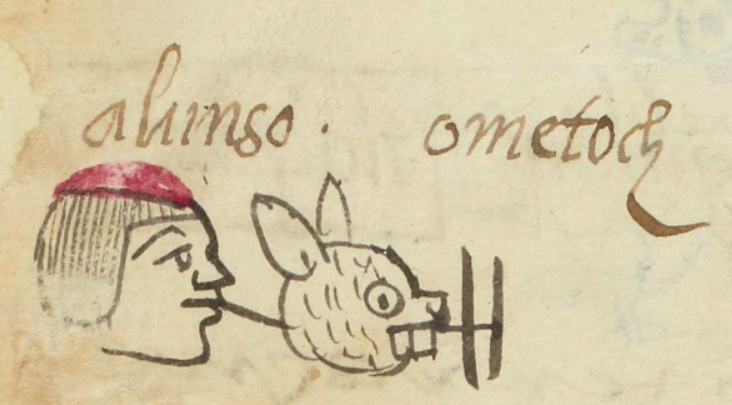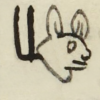Ometoch (MH642v)
This black-line drawing of the simplex glyph plus notation for the personal name Ometoch ("Two-Rabbit" or "2-Rabbit," attested here as a man's name) shows the head of a rabbit (tochtli) in profile, looking toward the viewer's right). The rabbit's eye is wide open, and its hair is textured or mottled. Its front teeth protrude and are very prominent. Connecting by a line to these teeth are two vertical lines that provide the notation of two (ome).
Stephanie Wood
Two-Rabbit is a calendrical name taken from the 260-day divinatory calendar called the tonalpohualli. The use of such names was in flux in the colonial context, but this one is traditional. Ometochtli has associations with divine forces linked to octli (pulque, a mildly alcoholic beverage).
Stephanie Wood
alunso. ometoch
Alonso Ometoch
Stephanie Wood
1560
Jeff Haskett-Wood
calendarios, días, fechas, animales, conejos, deidades, nombres de hombres

Ometoch(tli), divine forces associated with pulque, https://nahuatl.wired-humanities.org/content/ometochtli
ome, two, https://nahuatl.wired-humanities.org/content/ome
toch(tli), rabbit, https://nahuatl.wired-humanities.org/content/tochtli
Dos Conejo, o 2-Conejo
Stephanie Wood
Matrícula de Huexotzinco, folio 642v, World Digital Library, https://www.loc.gov/resource/gdcwdl.wdl_15282/?sp=367&st=image
This manuscript is hosted by the Library of Congress and the World Digital Library; used here with the Creative Commons, “Attribution-NonCommercial-ShareAlike 3.0 License” (CC-BY-NC-SAq 3.0).






